Johannes Kepler transformed the ancient cosmological tradition and laid the foundation for modern science by acknowledging astronomy as a branch of mathematical physics, which until then was seen as the humanities. The planetary motion laws referred to by his name laid the groundwork for Isaac Newton’s law of universal gravity; these laws still explain the orbits of not only planets but also dwarf planets, comets, asteroids, trans-Neptunian objects, and even superior planets, that is, planets of distant stars. He also laid the groundwork for modern optical science with his work with lenses, mirrors, and the human eye.
Who was Johannes Kepler?
Johannes Kepler was born in Weil der Stadt, an autonomous royal member of the Holy Roman Empire, to a German Lutheran family.He received his bachelor’s and master’s degrees from Tübingen University. Here he was the student of Michael Maestlin, one of the first to believe Copernicus’ Sun-centered theory. Kepler not only believed in the reality of heliocentrism but also thought it to be religiously important. He defended Copernicus’ views with both a theoretical and theological stance.
Although he wanted to become a priest, Kepler agreed to work as a mathematician in Graz, Austria, in 1594. As the mathematician for the region, he was expected to prepare an annual calendar and make astrological predictions. His work in 1595 made him known as a successful astronomer. The geometry he used in his lessons was effective in the publication of his book Mysterium Cosmographicum (Cosmographic Mystery) in 1596. This work is the first published defense of the Copernican System. It describes the divine structure of the universe based on the relationship between the five platonic solids, the speeds of the planets, and their distances to the Sun. Some of the people who read his work were the Italian mathematician Galileo Galilei, who admitted to being a supporter of Copernicanism, and the Danish nobleman Tycho Brahe, who said that his observations could help improve Kepler’s theory.
In 1600, Protestants were forced to leave the city of Graz. Kepler went to Prague to escape the growing religious tension, and Tycho became the royal mathematician of Emperor Rudolf II. When Tycho Brahe died in 1601, Kepler replaced him. It took more than 25 years to complete Tycho’s Rudolphine Tables by using his data. In the meantime, he worked on projects that would become the basis for two of his later masterpieces: Astronomiae Pars Optica (The Optical Part of Astronomy) from 1604 and Astronomia Nova (New Astronomy) from 1609.
Kepler’s first two laws of planetary motion
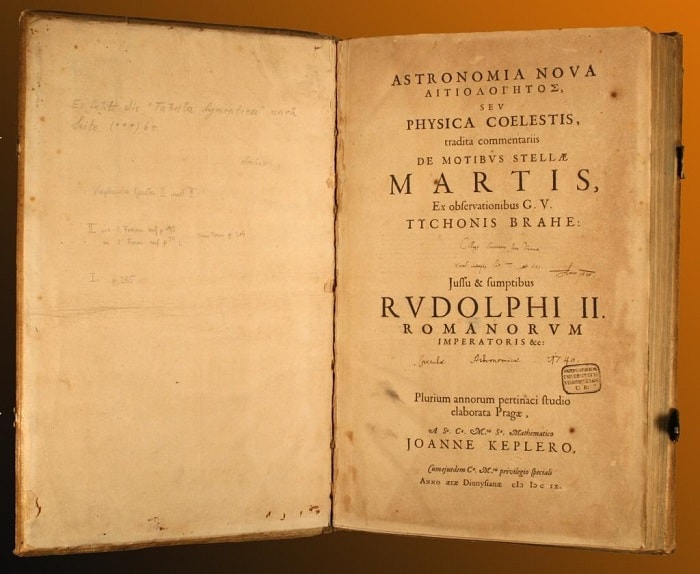
This first volume was the founding text of modern optics, which also describes the refraction of light, the inverse square law for calculating the intensity of light (as an intuitive assumption at the time), reflection in plane and convex mirrors, the pinhole camera, the correction of myopia and hyperopia with lenses, and the anatomy of the human eye and vision. The second volume was on the principles of planetary motions, which would bear Kepler’s name and make him literary.
Based on Tycho’s data on the orbit of Mars, Kepler proposed two of the laws for the movement of planets in the Astronomia Nova, now known as Kepler’s three laws:
- All planets move about the Sun in elliptical orbits, with the Sun as one of the foci.
- A radius vector joining any planet to the Sun sweeps out equal areas in equal lengths of time.
Astronomia Nova didn’t come out until 1609 because he had to talk with Tycho’s heirs, who were legally in charge of the data. Meanwhile, Tycho’s son-in-law, Frans Tengnagel, wrote a preface that warned Kepler’s readers of the author’s physical arguments. Despite this warning, Astronomia Nova is a mathematical masterpiece. Even though Newton’s law of gravity later disproved one of Kepler’s points, which said that the magnetic force of the sun caused the planets to move, Kepler’s laws about how the planets move are still right.
A message from Galileo to Kepler
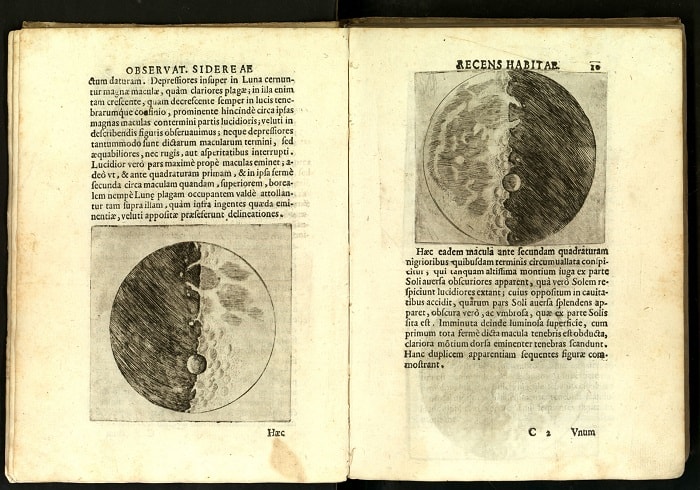
News that Galileo was using a new invention, the telescope, to study the sky was heard in Prague. Galileo sent a copy of Sidereus Nuncius (The Starry Messenger), to Kepler in the hope that positive evaluations from royal mathematicians would bring him more fame. Without a telescope, Kepler was not able to confirm Galileo’s observations. But he wrote a book called “Conversation with the Sidereal Messenger” (Dissertatio cum Nuncio Sidereo) to show that Galileo was the one who found Jupiter’s four moons.
Anti-Copernicans argued that if the Earth had revolved around the Sun, it would have lost its moon, but Jupiter still had its moons around it. So Kepler became the first astronomer to publicly support Galileo. In his 1611 book Dioptrice (Refraction), Kepler described how the arrangement of concave and convex lenses in Galileo’s telescope worked, and he introduced his new tool that has two convex lenses and provides more magnification compared to Galileo’s telescope—which is now called the Kepler telescope.
Kepler lived his golden age in Prague. In 1611, Emperor Rudolf II lost his mind, and his brother Matthias took over all his powers. When Rudolf died a year later, his brother Matthias became the Emperor. Matthias also appointed Kepler as an imperial mathematician. But he chose to allow himself to move away from political and religious affairs and go to the Upper Austrian Assembly in Linz as a mathematician.
The success and conflict in Linz
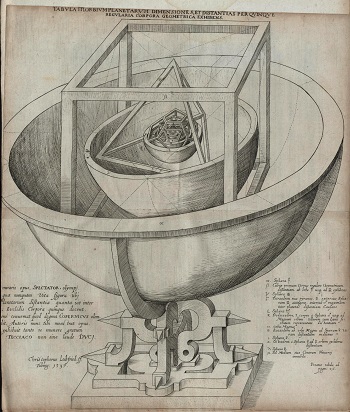
The fourteen years Kepler spent in Linz were as productive as his time in the imperial palace. His position allowed him to continue his research and also pursue his work on the Rudolphine Tables. Kepler sold wall calendars and tables that show the daily positions of the planets to support his income. In his 1613 book, he wrote about the optimal arrangement of packing objects–for example, placing oranges in crates–and its accuracy was only proven in the late 20th century. In 1615, Kepler’s Nova Stereometria doliorum vinariorum (New solid geometry of wine barrels) was the first book to be published in Linz. Aside from the surprising subject, in this book he contributes to the development of integral calculus and methods for the 20th century. In 1618 and 1620, he published the first and second volumes of his book Epitome Astronomiae Copernicanae, which is the textbook for the Copernican theory. The third and final volume came out in 1621 in Frankfurt.
Kepler’s third law of planetary motion
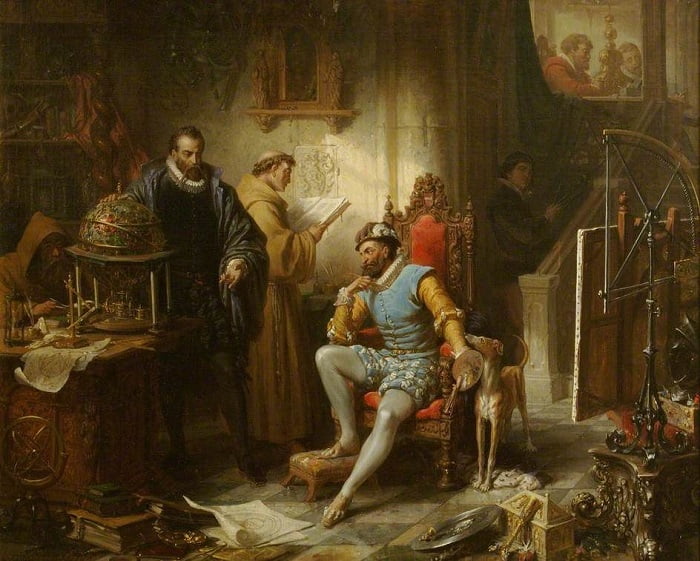
However, in addition to these professional achievements, Kepler also faced several challenges in his life in Linz. His first wife, Barbara, died before he left Prague, and he later met eleven candidates until he found 24-year-old Susan in 1613 eligible. Later, in 1615, he learned that his mother Katharina had poisoned another woman and was brought to court, accused of witchcraft. In 1617 and 1618, his two daughters and stepdaughter died in succession. In 1619, he went against the Lutheran Church with his strange ideas. For example, he said that not only Lutheranism but also Calvinism and Catholicism had religious truths.
However, he continued to work on the Rudolphine Tables and managed to concentrate on another important project. Kepler’s Harmonices mundi libri V book (Five Books on the Harmony of the World), published in 1619, included the third law of planetary motion. In this third law, he describes the relationship of a planet’s orbit with its distance from the Sun:
- The square of the orbital period of the planet is directly proportional to the cube of its average distance from the sun.
This law later formed the basis of Newton’s proof, which is that the force that keeps the planets in orbit, namely gravity, changes inversely proportional to the distance of the planet from the Sun. Thus, he harmonized the orbits of both the innermost planet Mercury, a planet that completed its orbit in 88 days, and the planet Neptune, discovered in 1846, which completed its orbit in 164 years. (Neptune has only completed its orbit once since it was discovered in 2010.)
Thirty Years’ War

Johannes Kepler spent the last 12 years in the shadow of the Thirty Years’ War, which happened between Catholics and Protestants in the Holy Roman Empire but spread across Europe for political domination. Shortly after the war started, Emperor Matthias of the Holy Roman Empire died. Months after, Catholic Archduke Ferdinand II took his place and ordered the people in Bohemia and Austria to be forced into Catholicism. Kepler’s ongoing work on the Rudolphine Tables obliged him to work in the Imperial Palace. But would it be possible to complete these astronomical tables by being a Protestant?
The solution to this problem was interrupted in 1620 when Kepler went to Württemberg to help her mother defend herself. His efforts were in vain. His mother was convicted and sentenced to 14 months in prison. When released in 1621, Kepler returned to Linz relatively peacefully. His appointment as an imperial mathematician was approved. He was told that he would be safe, but just before the Rudolphine Tables came out, Emperor Ferdinand II told all Protestants that they had to become Catholic or leave the city. This caused a Protestant uprising.
Despite being exempted from the order, Kepler was affected by the situation. In the summer of 1626, the villagers surrounded the city and set the outer quarters of the city on fire. The manuscripts of the Rudolphine Tables were saved, but the fire devastated the printing machine of the press. After the siege was lifted, Kepler asked if he could leave the city to find a shelter where he could print the Rudolphine Tables. This refuge was the city of Ulm (where Einstein would be born 250 years later), 100 miles from the Regensburg city of Bavaria, where Kepler had settled his family at the time.
Johannes Kepler and the first science fiction novel
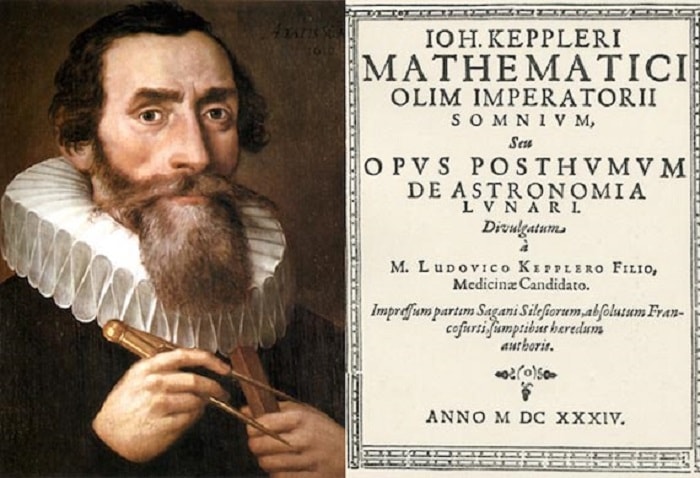
The Rudolphine Tables took advantage of the recently invented logarithm so that users could calculate the positions of the planets thousands of years ago or later. The telescopes and tables made it possible to observe the passage of Mercury in front of the Sun for the first time in history in 1631. In 1629, Kepler published a booklet to draw attention to this transit (and to the transit of Venus, although it couldn’t be observed from Europe). Kepler’s prediction of Mercury’s transit is considered one of the most successful predictions in the history of science. (However, he could not predict Venus’ transit in 1639. This phenomenon was later predicted by the modifications made in Kepler’s work.)
Johannes Kepler did not live to witness the transit of both planets. In December 1627, Kepler presented a copy of his tables to the Emperor, who rejoiced over the commander-in-chief of the imperial troops, Albrecht von Wallenstein, for his successful suppression of the Protestant uprising. Wallenstein was appointed to the Duchy of Zagan. In 1628, Kepler came to Zagan as Wallenstein’s personal mathematician. A few months after Kepler’s arrival, the Protestant majority of Zagan was forced into Catholicism or exiled. However, Kepler was spared by them. Wallenstein was dismissed in 1630 by the electoral princes at the meeting of the imperial assembly in Regensburg.
Worried about her future, Kepler went to Regensburg to assess the situation. He got sick on the road and died on November 15, 1630, in a house now known as the Kepler Museum. His last publication, which he started when he was a student in Tübingen but was published after his death, is about the astronomical applications made by the possible creatures on the Moon. Kepler’s The Dream is considered the first example of the science fiction genre. So, this early thinker of the scientific revolution is also thought to be the creator of a type of writing.
Johannes Kepler quotes
“If my false figures came near to the facts, this happened merely by chance….These comments are not worth printing. Yet it gives me pleasure to remember how many detours I had to make, along how many walls I had to grope in the darkness of my ignorance until I found the door which lets in the light of truth….In such manner did I dream of the truth.”
“I used to measure the skies, now I measure the shadows of Earth. Sky-bound was the mind, earthbound the body rests.”
“I believe Divine Providence arranged matters in such a way that what I could not obtain with all my efforts was given to me through chance; I believe all the more that this is so as I have always prayed to God that he should make my plan succeed, if what Copernicus had said was the truth.”
“We do not ask for what useful purpose the birds do sing, for song is their pleasure since they were created for singing. Similarly, we ought not to ask why the human mind troubles to fathom the secrets of the heavens… The diversity of the phenomena of Nature is so great and the treasures hidden in the heavens so rich, precisely in order that the human mind shall never be lacking for fresh nourishment.”
“… not my own opinion, but my wife’s: Yesterday, when weary with writing, I was called to supper, and a salad I had asked for was set before me. ‘It seems then,’ I said, ‘if pewter dishes, leaves of lettuce, grains of salt, drops of water, vinegar, oil and slices of eggs had been flying about in the air for all eternity, it might at last happen by chance that there would come a salad.’ ‘Yes,’ responded my lovely, ‘but not so nice as this one of mine.”
Johannes Kepler
Bibliography:
- Barker and Goldstein. “Theological Foundations of Kepler’s Astronomy”, pp. 112–13.
- Kepler. New Astronomy, title page, tr. Donohue, pp. 26–7
- Kepler. New Astronomy, p. 48
- Epitome of Copernican Astronomy in Great Books of the Western World, Vol 15, p. 845
- Stephenson. Kepler’s Physical Astronomy, pp. 1–2; Dear, Revolutionizing the Sciences, pp. 74–78
- Barker and Goldstein. “Theological Foundations of Kepler’s Astronomy,” pp. 99–103, 112–113.
- Caspar. Kepler, pp. 65–71.
- Field. Kepler’s Geometrical Cosmology, Chapter IV, p 73ff.
- Dreyer, J.L.E. A History of Astronomy from Thales to Kepler, Dover Publications, 1953, pp. 331, 377–379.
- Caspar. Kepler, pp. 29–36; Connor. Kepler’s Witch, pp. 23–46.
- Koestler. The Sleepwalkers, p. 234 (translated from Kepler’s family horoscope).
- Caspar. Kepler, pp. 36–38; Connor. Kepler’s Witch, pp. 25–27.
- Connor, James A. Kepler’s Witch (2004), p. 58.
- Barker, Peter; Goldstein, Bernard R. “Theological Foundations of Kepler’s Astronomy”, Osiris, 2nd Series, Vol. 16, Science in Theistic Contexts: Cognitive Dimensions (2001), p. 96.


